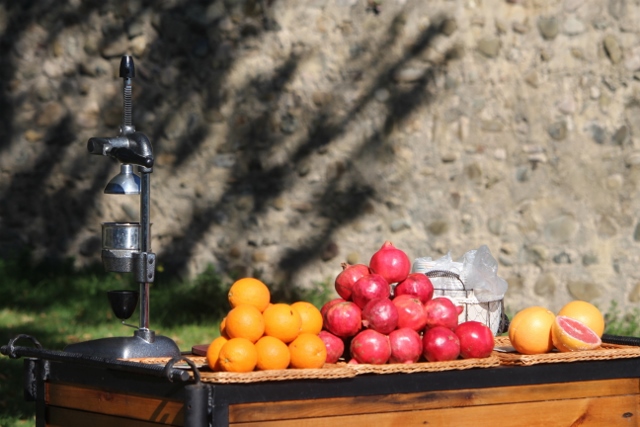Telavi itself is not of much interest, but the town is surrounded by some fabulous churches and cathedrals, many supporting the remains of vivid frescos.
The small town of Telavi is the capital of the province Kakheti, the most important wine-producing region of Georgia. So it is no coincidence that we have set up our base here for a few days. The centre is dominated by the Batonistsikhe citadel, a crenulated fortification that contains the art museum and the old palace of King Erkele II. The palace seems to be closed indefinitely; the museum is only closed today, probably because someone important is on its way, because the place is teeming with police. A brief walk through the rest of town does not yield anything else of interest – except for the many wine making and wine tasting and wine selling facilities, of course. But not in the morning.
Of immediate concern is the mending of our tyre, which turns out to be beyond repair. A very nice guy tries to explain that we really need to buy a new one, or a new second hand one, for 15 US$ or so, then puts on the tyre, quickly repairs another one, too, because it doesn’t look good, ties some more loose parts – the trip to Tusheti hasn’t been kind to our rental car -, and refuses to charge anything extra. Maybe the Georgians, or some of them, are nice people, after all.
With a new second hand tyre, we start our tour of the Telavi area, which for the moment is going to be church- and monastery-dominated. Our first stop is the Dzveli Shuamta Nunnery (old Shuama), which looks more like a church. There doesn’t seem to be anybody staying here. It is a nice building, great setting on a hill, but inside not particularly special, no frescoes or anything, and the icons look like, and probably are, posters. At the foot of the hill is the Akhal Shuamta – new Shuama – Nunnery. The guidebook describes the nuns as “somewhat fierce and unwelcoming”; at the entrance is a sign saying that the church is closed for renovation, and only pilgrims are welcome in the chapel. Message clear, we are not welcome.
A little further, in Ikalto, there is a large complex with three churches, all relatively small, and whitewashed on the inside; there are no fescoes left. But obviously, one of the other priorities of the church people, wine making, left its traces, in the form of an antique wine press and tens, if not hundreds, of qvevris, the traditional clay vessels in which then, like now, wine was being made.
We have lunch in a winery, one we find along the road. In fact, they are closed, because yesterday they had their harvest festival – the guy admitted that they had perhaps drank a little too much – but as we are just the two of us, they are prepared to serve us some food. They also make sure we taste all of their wines. A qvervi-type of white, of which we – unfortunately – get a very full glass, wasn’t exactly our taste. And, or so they claim, the superior saperavi, equally full glass, was equally not so much our taste, but it came from a good, and generous heart, so we finish both glasses. I told you, here in Katheti the people are a lot nicer – or maybe we have learned to warm to the Georgians. Who knows, perhaps this badly-started love affair will work out, after all.
After lunch we drove on to Alaverdi, to the Cathedral of Saint George. Yet another church? No, really, this was a whole new experience, and not only because when we arrived there were no other tourists. The church is quite big, and with its 50 meters high one of the tallest in Georgia. Inside, several baskets of candles provide some very atmospheric lighting, which is enhanced by the music, Georgian chants, very appropriate to the setting. This is a place to sit down quietly, and appreciate the peacefulness, whilst appreciating the frescoes around – the church was, apparently, whitewashed by the Russians in the 19th Century, but now the frescoes are slowly being uncovered and where possible restored again. As in all churches here, women need to cover their head, and are expected to wear skirts; if with trousers, a wrap is being provided to do as if. But here the tradition is carried even further: when I cross my legs, whilst sitting down, I am kindly instructed to uncross them again. You don’t cross your legs in a church.
The citadel in Gremi is being restored, and the tower and another part of the complex are covered in scaffolding. But the small church here is beautifully decorated, with frescoes of the 16th Century – totally different again from the cathedral in Alaverdi, or any of the other churches we have seen so far. And the monastery complex of Nekresi, a little further along the road, and with a basilica of the 4th Century one of the oldest churches in Georgia, breathes yet another atmosphere, more sterile, although the small church is once more covered in the most fabulous, vibrant frescoes.
So a potentially boring ‘church’ day actually developed into a very nice and diverse day visiting a wide variety of places of worship, all very different in their designs, and the atmosphere they invoke. Interesting, that variety.
next: there are also wineries around Telavi!


































